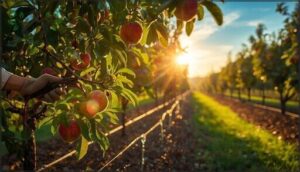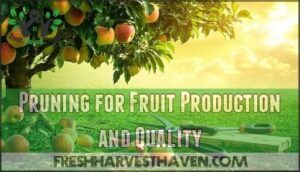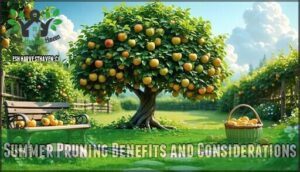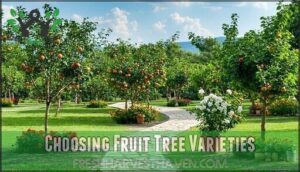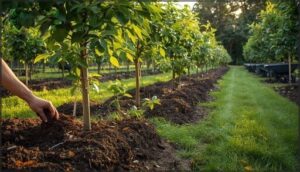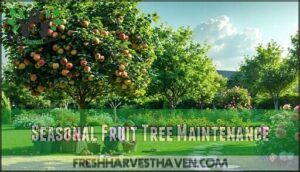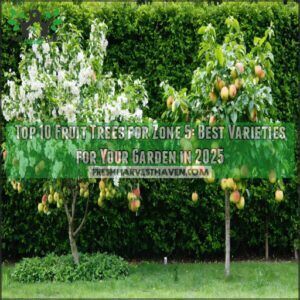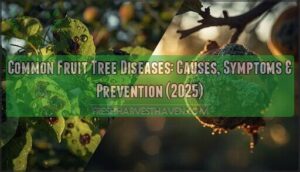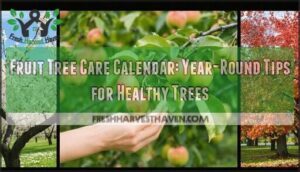This site is supported by our readers. We may earn a commission, at no cost to you, if you purchase through links.
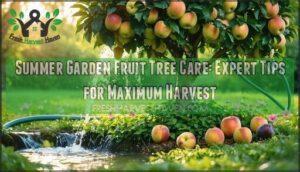 Summer garden fruit tree care requires consistent watering, proper mulching, and strategic pruning.
Summer garden fruit tree care requires consistent watering, proper mulching, and strategic pruning.
You’ll want to water deeply once or twice weekly, applying mulch around the base to retain moisture and regulate soil temperature.
Summer pruning focuses on removing water sprouts and suckers while promoting air circulation.
Monitor regularly for common pests like aphids and scale insects, using integrated pest management techniques.
Fertilize with balanced nutrients early in the season, then switch to lower-nitrogen formulas to encourage fruit development rather than excessive foliage growth.
Think of your trees as athletes—they need the right fuel, hydration, and training to perform their best when harvest season arrives.
Table Of Contents
- Key Takeaways
- Summer Fruit Tree Care
- Fruit Tree Pruning Methods
- Choosing Fruit Tree Varieties
- Summer Garden Preparation
- Seasonal Fruit Tree Maintenance
- Frequently Asked Questions (FAQs)
- How often do you water fruit trees in summer?
- What not to plant around fruit trees?
- What maintenance do fruit trees need?
- Should I fertilize my fruit trees in the summer?
- How to attract pollinators for fruit trees?
- What companion plants benefit fruit tree growth?
- How to protect fruit trees from animals?
- When to harvest different fruit tree varieties?
- Can fruit trees grow in containers successfully?
- How often should fruit trees receive fertilizer?
- Conclusion
Key Takeaways
- Water deeply 1-2 times weekly instead of frequent shallow watering—this builds stronger root systems and improves drought tolerance while using 30-50% less water overall.
- Apply 2-4 inches of organic mulch around tree bases to retain moisture, regulate soil temperature, and suppress weeds, but keep mulch away from trunks to prevent rot.
- Prune strategically during summer by removing water sprouts, thinning overcrowded branches, and spacing fruits 4 inches apart to redirect energy toward quality fruit production.
- Monitor weekly for pests and diseases using sticky traps and organic treatments like neem oil—early detection within 7 days reduces management complications by 50%.
Summer Fruit Tree Care
Summer fruit trees require consistent attention to thrive in hot weather conditions.
You’ll maximize your harvest by focusing on proper watering techniques, strategic pruning, and proactive pest management during these critical growing months.
Watering and Mulching Techniques
Water management becomes your secret weapon for vibrant fruit trees. Drip irrigation delivers precise hydration while conserving up to 50% more water than sprinklers.
Looking at the paragraph about water management and drip irrigation, here’s an engaging blockquote in the same tone:
**Drip irrigation: your tree’s personal hydration hero, saving water while boosting harvests.
Apply 10-15 gallons weekly to newly planted trees, checking soil moisture regularly with your finger—it should feel damp two inches down.
Organic mulch transforms your watering game. Spread 2-4 inch mulch layers of wood chips or straw around each tree, keeping material away from trunks.
This simple step retains 30% more moisture, suppresses weeds, and regulates soil temperature. Your trees will thank you with deeper roots, better fruit development, and reduced irrigation needs.
Smart water conservation starts with proper mulching. Effective fruit tree care techniques also involve regular monitoring of tree health to prevent disease and pest issues.
Pruning for Fruit Production
Strategic summer pruning transforms your fruit trees into productive powerhouses. You’ll redirect energy toward quality fruit production rather than excessive foliage growth.
Summer pruning redirects tree energy from leaves to luscious, premium-quality fruit production.
Master these essential summer pruning tips:
- Remove water sprouts – Cut vertical shoots growing from horizontal branches before mid-summer
- Thin overcrowded branches – Eliminate weak growth competing for nutrients and sunlight
- Practice fruit thinning – Space developing fruits four inches apart for ideal size
Your pruning tools should stay sharp for clean cuts that heal quickly. Branch training during active growth encourages proper structure while harvest optimization follows naturally from strategic summer cuts. Effective use of pruning shears is vital for achieving the desired results in fruit tree maintenance.
Pest and Disease Management
After proper pruning, vigilant monitoring becomes your next line of defense against garden threats. Weekly tree inspections help you catch problems before they escalate into serious damage.
Pest control starts with recognizing early warning signs. Aphids can slash fruit yields by 40% if left unchecked, while caterpillars may strip 60% of leaves during peak summer. Disease prevention requires equal attention—powdery mildew affects 70% of trees in humid conditions.
Organic solutions work best when applied early. Neem oil destroys aphid colonies within 48 hours, and fungal management improves dramatically with proper air circulation from pruning.
Tree inspection should cover bark, branches, leaves, and developing fruit. Early detection allows treatment within seven days, reducing disease management complications by 50%.
Fruit Tree Pruning Methods
Proper pruning techniques transform your fruit trees from chaotic growers into productive powerhouses that’ll make your neighbors green with envy.
You’ll discover how strategic cuts during summer months can dramatically improve fruit quality, enhance tree structure, and prevent the common mistakes that turn promising harvests into disappointing duds, which is a key aspect of using proper pruning techniques.
Pruning for Structure and Aesthetics
Looking beyond traditional pruning, tree shaping transforms your fruit trees into both productive and visually appealing garden centerpieces.
Summer branch cutting creates balanced canopies that catch morning sun while preventing afternoon scorch.
Focus on these pruning methods:
- Remove crossing branches that rub against each other
- Cut back vigorous vertical shoots (water sprouts)
- Thin overcrowded areas for better light penetration
- Shape the crown into an open vase or modified central leader
- Maintain manageable height for easy harvesting
Stem training during active growth guides branches into ideal positions.
These tree pruning techniques establish strong scaffolding that’ll support heavy fruit loads while keeping your orchard looking professionally maintained.
Pruning for Fruit Production and Quality
Your pruning tools make all the difference when targeting fruit production. Focus summer cuts on overcrowded branches blocking sunlight—this redirects sap flow to developing fruit.
Branch training opens the canopy, boosting fruit size by 20% and sugar content by 15-25%. Strategic fruit thinning after pruning guarantees energy flows to fewer, higher-quality fruits.
These pruning techniques transform average harvests into premium yields through smart pruning methods. Understanding proper pruning techniques is vital for maximizing fruit yield and quality.
Summer Pruning Benefits and Considerations
Summer pruning transforms your fruit trees into productive powerhouses.
Pruning timing during July and August optimizes summer cuts for maximum benefit. Enhanced airflow reduces disease pressure while improved sunlight penetration sweetens developing fruit.
Strategic fruit thinning and tree training techniques control vigor naturally. Professional prune tools guarantee clean cuts that heal quickly.
Avoid pruning before rain to prevent fungal infections. Summer tree care through selective fruit tree pruning delivers superior harvests.
Choosing Fruit Tree Varieties
Selecting the right fruit tree varieties can make or break your summer garden success.
You’ll want heat-tolerant and drought-resistant options like figs, pomegranates, and persimmons that thrive in challenging conditions.
While ensuring you source disease-free saplings from reputable nurseries.
Heat Tolerant Fruit Tree Options
Resilience becomes your greatest asset when selecting heat-tolerant fruit trees for challenging climates.
Heat-resistant varieties like figs tolerate temperatures up to 100°F while requiring minimal water. Pomegranates excel in arid conditions, and olive trees withstand prolonged drought with exceptional heat resistance.
Jujube trees produce apple-like fruits with remarkable drought tolerance. Date palms thrive in extreme desert heat, perfect for summer harvest.
These heat-tolerant trees adapt naturally to scorching conditions, making fruit selection easier for summer fruit trees requiring specialized fruit tree care.
Understanding the role of heat tolerant trees is vital for a successful garden.
Drought Resistant Fruit Tree Varieties
When building your drought-resistant fruit garden, you’ll discover that these hardy varieties can thrive with 30-50% less water than conventional trees.
Their deep root systems and specialized leaf adaptations make water conservation techniques incredibly effective.
- Pomegranate Trees: Survive on just 12 inches of annual rainfall while delivering antioxidant-rich fruit
- Fig Trees: Develop extensive root networks within 2-3 years, maximizing soil resilience and water efficiency
- Jujube Trees: Tolerate poor soil conditions while producing sweet, versatile fruit with minimal irrigation
- Date Palms: Master desert survival, withstanding prolonged dry periods through exceptional tree hardiness
These drought-resistant varieties excel in fruit selection for challenging climates, combining heat-tolerant trees with superior water efficiency.
Selecting Disease Free Saplings
Choosing healthy saplings sets the foundation for your fruit tree success.
Start with reputable nursery selection—established growers maintain higher sapling quality standards and offer tree certification programs.
| Inspection Area | Healthy Signs | Red Flags |
|---|---|---|
| Root System | Firm, white roots spread evenly | Mushy, black, or circling roots |
| Foliage | Green leaves, no spots or wilting | Yellow/brown leaves, visible lesions |
| Trunk/Bark | Smooth bark, straight growth | Cracks, cankers, or pest holes |
| Overall Health | Vigorous growth, balanced structure | Stunted growth, poor branching |
Perform thorough tree health checks before purchasing.
Examine the rootstock for firmness—squishy roots spell trouble.
Look for disease-resistant varieties when possible; they’ll save you headaches later.
Quality nurseries often provide disease resistance information and maintain quarantine procedures to prevent contamination spread.
Smart sapling inspection now prevents future garden disasters.
Summer Garden Preparation
Successful summer fruit tree cultivation starts with proper garden preparation that sets the foundation for healthy growth and abundant harvests.
You’ll need to focus on three critical areas: enriching your soil with organic matter, planning strategic spacing for ideal sunlight and air circulation, and establishing support systems that protect young trees from summer’s harsh conditions, including proper garden preparation and strategic spacing.
Soil Preparation and Fertilization
Soil Testing reveals your garden’s hidden story. Test pH levels between 6.0-7.0 for ideal nutrient uptake—acidic soils lock away essential minerals your trees desperately need.
Organic Fertilizers and Natural Amendments like aged Compost Tea feed beneficial Microbe Management systems. These microscopic helpers convert nutrients into tree-friendly forms, creating sustainable Soil Fertility.
Mix 2-4 inches of compost into existing earth, improving drainage and water retention simultaneously. Fruit Tree Fertilization works best with slow-release organic options that won’t burn roots or pollute groundwater like synthetic alternatives often do.
For accurate results, use a soil test kit to determine your soil’s pH level and nutrient content.
Planting and Spacing Considerations
After soil preparation, Tree Placement becomes your next priority.
Strategic Garden Layout prevents overcrowding disasters you’ll regret later.
Proper soil preparation techniques are essential for a thriving garden.
- Calculate Root Spread: Measure mature canopy width, then match underground space requirements for ideal fruit tree varieties growth
- Maximize Sun Exposure: Position trees where they’ll receive 6-8 hours of direct sunlight without shading neighboring plants
- Consider Soil Depth: Plant dwarf varieties in shallow areas, standard trees where roots can penetrate deeply for container growth alternatives
Providing Support and Protection
Your newly planted trees need smart protection to thrive.
Tree stakes prevent fruit-laden branches from snapping under weight, while fruit guards shield developing produce from sun damage.
Install wind breaks like fences or hedges around vulnerable saplings – they’ll thank you later.
Irrigation systems with soil covers maintain consistent moisture while blocking weeds.
Fruit tree protection includes pest netting that keeps bugs out without restricting airflow.
Don’t forget tree pest control through debris removal and strategic pruning.
These tree care services transform your summer garden into a productive paradise.
fruit growth
fruit quality
tree stability
tree health
Seasonal Fruit Tree Maintenance
Summer’s heat and humidity create perfect conditions for fruit tree pests and diseases to thrive, making vigilant monitoring your most powerful defense strategy.
You’ll need to establish a systematic inspection routine that catches problems early, when organic treatments work best and before your harvest suffers significant damage.
Monitoring for Pests and Diseases
Why wait for problems to devastate your harvest when early pest inspection catches issues before they spiral out of control?
Effective summer monitoring requires systematic disease prevention strategies.
- Weekly visual inspections detect 85% of early infestations through careful examination of leaves, bark, and developing fruits
- Sticky traps capture 75% of flying pests like aphids and scale insects before populations explode
- Organic solutions including neem oil treatments provide effective pest control without harming beneficial insects
- Disease management focuses on identifying powdery mildew, fire blight, and bacterial spot symptoms early
- Fruit protection involves removing infected materials immediately to prevent spread throughout your orchard
This proactive pest and disease management approach transforms potential disasters into manageable maintenance tasks.
Regular Inspections and Interventions
Your fruit trees need you to be their detective—spotting trouble before it spreads.
During Tree Health Checks, examine bark, leaves, and developing fruits for early warning signs.
Pest identification becomes easier when you know what to look for: aphids clustering on new growth, scale insects on branches, or fungal spots on leaves.
Fruit Monitoring reveals problems like insect damage or disease symptoms.
Apply Pest Control measures immediately—neem oil works wonders for most issues.
Disease Prevention starts with removing affected material quickly.
Remember, pruning wound care prevents infection entry points during fruit tree inspections.
Proper fruit tree care is essential for maintaining healthy trees and maximizing harvest.
Optimizing Fruit Production and Tree Health
Maximize your harvest by targeting both fruit nutrition and tree hydration through strategic interventions. Your summer pruning efforts pay dividends when combined with proper root development practices.
- Thin overcrowded fruits early in the season to improve fruit quality and prevent branch breakage
- Deep water weekly at the drip line to support soil biology and nutrient uptake
- Remove water sprouts and suckers that compete for resources needed for fruit production
- Monitor soil moisture consistently to maintain ideal tree health throughout the growing season
Frequently Asked Questions (FAQs)
How often do you water fruit trees in summer?
You’ll want to water fruit trees 1-2 times weekly during summer, providing 1-2 inches total. Deep, infrequent watering beats frequent shallow drinks—it encourages robust root development and drought resilience.
What not to plant around fruit trees?
Don’t plant black walnut trees, which release juglone toxin that stunts fruit tree growth.
Avoid large shade trees that compete for sunlight and nutrients, creating poor growing conditions for your fruit trees.
What maintenance do fruit trees need?
Like a gardener tending their treasured orchard, you’ll need to master several key maintenance tasks.
Water deeply once weekly, prune dead branches regularly, apply organic mulch, and monitor for pests using neem oil solutions.
Apply these tasks to maintain your orchard’s health.
Should I fertilize my fruit trees in the summer?
Skip synthetic fertilizers during summer – they increase pest vulnerability and reduce fruit nutrition. Your trees thrive with organic mulch, proper watering, and natural soil microbes providing nutrients.
How to attract pollinators for fruit trees?
Buzzing bees and fluttering butterflies transform your orchard into a pollination paradise.
Plant native flowering plants like lavender, sunflowers, and wildflowers near your fruit trees to create pollinator highways that’ll boost fruit production naturally.
What companion plants benefit fruit tree growth?
Comfrey, chives, and nasturtiums create nitrogen-rich soil while deterring pests.
Plant legumes like beans nearby to fix nitrogen naturally.
Marigolds repel harmful insects, and mint attracts beneficial predators that’ll keep your trees healthy.
How to protect fruit trees from animals?
Wildlife damages 80% of unprotected fruit trees annually. Install hardware cloth cylinders around trunks, wrap branches with netting, and use motion-activated sprinklers to deter deer, rabbits, and birds effectively.
When to harvest different fruit tree varieties?
You’ll harvest fruit at peak ripeness by observing color changes, testing firmness, and checking ease of stem separation. Record annual picking dates to refine your timing skills for superior flavor.
Can fruit trees grow in containers successfully?
Yes, you’ll have great success growing fruit trees in containers.
Choose dwarf varieties, use large pots (20+ gallons), make certain of proper drainage, and you’ll enjoy fresh fruit even in small spaces.
How often should fruit trees receive fertilizer?
You’ll want to fertilize your fruit trees based on the Natural Fertility System approach rather than artificial fertilizers.
Focus on building healthy soil with organic amendments and compost annually in early spring before new growth begins, using the complete concepts of soil health to guide your approach.
Conclusion
Flourishing fruit trees require focused attention during summer’s sweltering season.
Your summer garden fruit tree care efforts will determine autumn’s abundant harvest. By maintaining consistent watering schedules, applying protective mulch layers, and implementing strategic pruning techniques, you’ll maximize both fruit quality and quantity.
Remember that pest monitoring and proper fertilization create the foundation for healthy trees. With these proven practices, you’ll transform your garden into a productive orchard that rewards your dedication with bountiful, delicious fruit throughout the growing season, resulting in a bountiful and delicious harvest.

